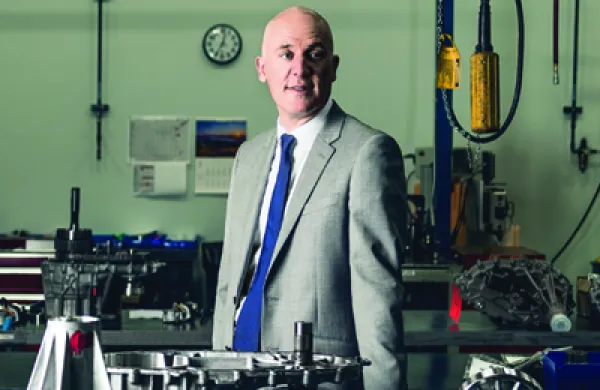In his nine years as CEO of Equinix, Stephen Smith has had more than a few people confuse the name of his Redwood City, California–based data center company with that of fitness club operator Equinox. Smith tells a funny story about an appearance he made on CNBC a few years ago when the guy being interviewed prior to him was the CEO of Equinox: “After he finished his interview, I introduced myself and asked him, ‘Does anybody ever confuse you with Equinix?’ He just paused for a second and said, ‘No, never. Steve, we’re in the health club business.’”
Smith concedes that the name Equinix — an acronym for “equality, neutrality and Internet exchange” — is difficult to pronounce, but he has resisted suggestions along the way from “some big-time CEOs” to consider changing it. “And now it’s just too late,” he says. “We’re too deep into the Internet.”
With 145 data centers in 40 of the biggest markets in the world, Smith’s outfit is well known today among the Internet’s largest players — cloud computing firms, digital media companies and network providers — most of which house at least some of their computer servers and networking equipment in locked cages within Equinix facilities. Known for their state-of-the-art design and uncompromising security, Equinix’s cavernous data centers provide a place for companies in dozens of industries to connect directly with one another — creating an “interconnection” platform that brings “data and applications closer to end-users in pursuit of a modern cloud strategy,” according to a recent report by Stifel Nicolaus analyst Matthew Heinz.
Equinix has invested more than $12.5 billion in building out its global footprint since the company was founded in 1998 by former Digital Equipment Corp. facilities managers Jay Adelson and Al Avery. When Smith left Hewlett-Packard Co. in 2007 to become CEO of Equinix, it had about $400 million in annual revenue and a market cap of $6 billion. In May, Equinix reported $844 million in first quarter revenue, its 53rd straight quarter of sequential topline growth, helping the company increase its market cap to nearly $24 billion. At a recent price of $340, shares of Equinix, which was converted to a real estate investment trust (REIT) in January 2015, have soared 365 percent since the start of 2011.
Smith, who turns 60 later this month, grew up in Brasher Falls, a small town about 60 miles northwest of Lake Placid, New York. His parents were teachers. An avid high school athlete, Smith was recruited to play football at the U.S. Military Academy at West Point. Following his graduation in 1979 with a BS in engineering, he spent eight years in the Army, including two stationed in Hawaii as an aide-de-camp to the office of the Commander-in-Chief of the Pacific Fleet (CINCPAC).
Smith resigned from the Army in 1987 and “went to another military called EDS” — H. Ross Perot’s Plano, Texas–based Electronic Data Systems Corp. — which recruited West Point grads. During his 16 years at EDS, where he started in sales, Smith lived all over the world. “It was kind of like IBM in those days,” he says. “If you wanted to move up, you had to be willing to move around.” In 2004, he left EDS, which had started to falter, to lead Lucent Technologies’ outsourcing business. Two years later he was recruited by HP to run its $16 billion outsourcing, consulting and technologies services business.
Institutional Investor Editor Michael Peltz recently met with the Equinix CEO to discuss his business and how his time in the military shaped the way he manages it.
Institutional Investor: What did you learn from your Army days stationed in the Pacific, working for CINCPAC?
Steve Smith: It was very interesting. I worked with a whole bunch of generals. It’s a four-star post, and they run all the forces in the Pacific. I traveled all over Asia. I went to all these countries where the U.S. had forces. My job was to make sure that when the generals traveled, their schedule was ready, the interpreters were there. I worked every day for 18 months. It was 24/7. So you see and touch a lot — very highly confidential information about what was going on in Asia. I learned a lot about discipline. I learned a lot about planning. I learned a lot about great leaders. That pretty much shaped my early leadership philosophy, for sure.
How would you describe that philosophy?
There are a lot of elements. I have a mantra here at this company where we talk about the three Ls — listen, learn and then lead — and a term we call PR. One of the things I learned during those days is you have to be a great listener. You have to learn your job and what you’re doing and your team before you start leading. So that’s carried with me for many, many years. The PR stands for patience and respect for people. When you’re a global company, you have to be very patient and have respect for multiple cultures.
In the military I definitely learned the art of acting from understanding versus from bravado. It’s easy when you’re a captain and when you’re, for example, an aide to a general. You can get stuff done by just showing up and saying, “Hi, I’m General So-and-So’s aide.” People tend to jump really high. But in the business world, it’s all about consensus and acting from understanding and bringing people along.
How important is culture to Equinix?
Culture is really important to us. I think culture determines your destiny. It determines your longevity. We work really hard on a culture where if people enjoy each other, they trust each other, they trust their leaders and they’re proud of where they work, you’re going to have a magical place. And so, we spend a lot of time practicing it, thinking about it, talking about it, documenting it.
What was the culture like when you got to Equinix?
The culture was very good. It was humble. It was informal. People worked hard. They got stuff done, and they knew how to have fun. Most of the stuff I’ve done is work to preserve it. We describe our culture as informal because you tend to get things done quicker when you’re informal. It just speeds things up. You don’t have a lot of bureaucracy and layers of decision making. It’s a very unique culture for an Internet infrastructure business that is not widely known in consumer circles — for an infrastructure company that’s sort of like a Cisco. Although Cisco makes the stuff that makes the Internet work, we design and build data centers that house all the servers and storage arrays and networking gear that makes the Internet work.
How does network neutrality fit into Equinix’s business model?
We have over 1,100 networks connected into 145 data centers, and companies can choose any of these networks when they come into our data centers to move their traffic around the world. We don’t favor one network over the other. We’re neutral. That was the premise of the original model, and it’s been preserved now for more than 17 years.
And then we have all these technology platforms we’ve built to exchange traffic. We have Internet exchanges and cloud exchanges, so we can exchange traffic between cloud providers. We can exchange traffic between Internet providers. We can exchange traffic between network providers. And that’s the secret sauce of the company. We call it interconnection, and we have a whole bunch of different ways to monetize it. It’s a major piece of the core of the company because, as you know, the whole world is becoming more and more interconnected. So as the premise started to interconnect networks, that led to content companies like the Yahoos and the Googles and the Microsofts coming to Equinix because they could find all the networks and move content all over the world.
How has Equinix’s business mix evolved over the years?
Seven or eight years ago, when the whole financial system went electronic and all the different asset classes needed to be traded around the world, they found Equinix because of two things: latency — they could move traffic in microseconds — and proximity. We facilitate trillions of dollars of electronic trading every day in probably eight or nine of the biggest financial markets in the world.
The last five years, the cloud has found us. I say “found us”; we obviously helped go find it. But all the biggest cloud providers in the world have come into Equinix because of the networks, and they make it easy for an enterprise to come in and find them.
And then the last three years, it’s gone to this “as a service” model. You still have to put physical infrastructure all over the world next to your revenue, next to your employees, and then in these markets where we have these data centers, you can find Microsoft Office 365, you can find Microsoft Azure, you can use Google apps, you can burst into Amazon Web Services.
So all these big cloud providers — the software guys, the hardware guys, the platform guys — have populated our data centers across many markets with what they call access nodes or network nodes or cache nodes, and these are just racks of servers and storage arrays that make it very easy for a company to come in and interconnect to. When they do that, we can move their traffic and their video and their stuff all over the world. The reason you can download a Netflix video in 10 to 12 seconds anywhere in the world is that they have a bunch of servers that sit all over the world inside data centers like Equinix’s.
Can you talk about Equinix’s enterprise business?
For the first 15 years of our history we mostly focused on four industries: the networks, content digital media companies, financial services and the cloud providers. That was where the company focused. And then along the way, we accumulated nearly 1,200 enterprises: pharmaceutical companies, health care companies, travel and transportation, oil and gas. There’s probably a dozen industries out there that we call the enterprise.
Well, there’s some 350,000 enterprises around the world that have at least $10 million in sales and about 500 people. Over the next ten to 15 years, Equinix is going to get more of those enterprises to come out of their on-premise data centers and use our facilities to take advantage of the multi-cloud.
What was the rationale behind turning Equinix into a REIT?
A lot of the other data center providers were already real estate trusts, and we were 17 years into the game here, and we were looking at our tax position around the world. We were looking at what was the best structure for Equinix as we continued to scale the company and determined that we were qualified as a REIT. You have to apply to the IRS. It took several months for the IRS to opine on it. They finally approved it last year.
How does being a REIT change the way you approach the business?
It doesn’t change the model much at all. We still are a technology company with a global tax optimization structure around us. Our day in and day out activities, it doesn’t change. For the legal and the finance people, it changes quite a bit in terms of how we report, how we are measured for real-estate-type metrics. But it didn’t change our relationship with our customers at all. •
Follow Mike Peltz on Twitter at @mppeltz.





